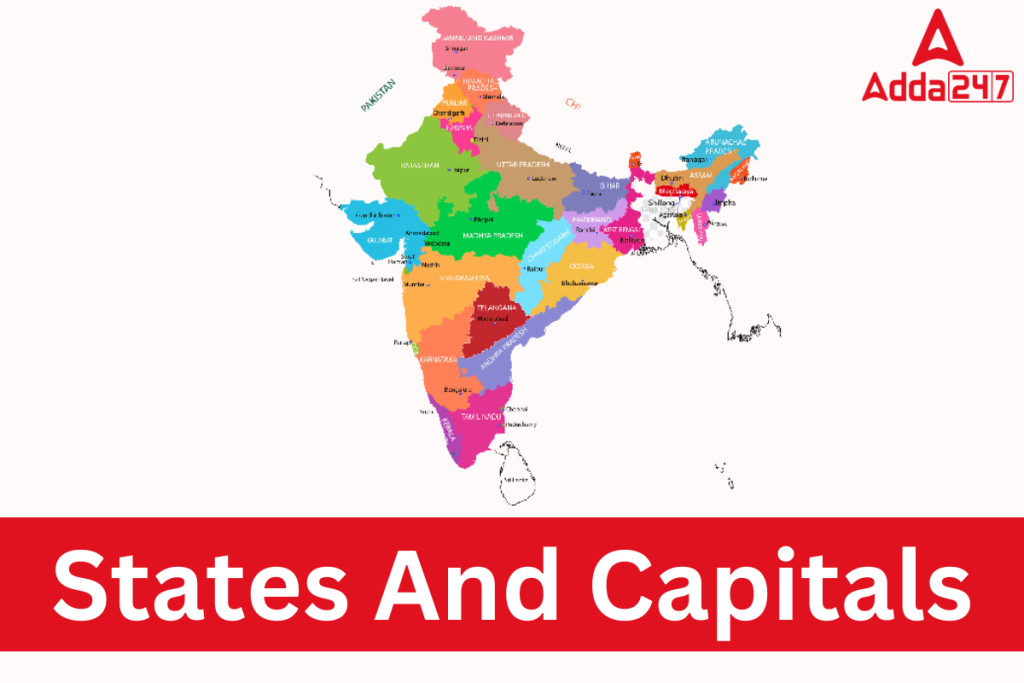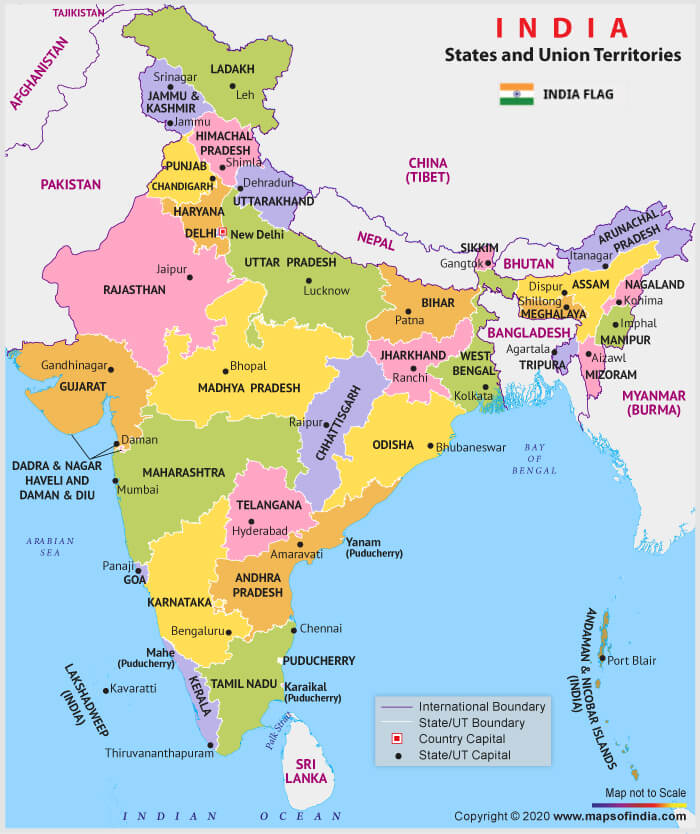
States and Capitals of India 2023: India (Bharat) is located in the Southern part of the largest continent in the World, Asia and is officially known as the Republic of India. It is governed by the parliamentary form of government. There are 28 states and 8 union territories (UT’s) in India, as per the latest data of the year 2022. Each state and union territory in India has an administrative, legislative and judicial capital. Every state is ruled by a Chief Minister. Here we have covered the list of the Indian States, Union Territories, and their capitals.
India is the second most popular country in the whole world. It is also considered to be the 7th largest country all around the world. Being such a large country, it can become difficult to manage the country activities it. Indian constitution provided Central Government the right to divide the country into different States and UTs as per suitability. All the details related with States and Union Territories of India are covered in this article below.
States and Capitals of India- Map Of India

Date of Formation of Indian States and Capital Since 1947
Check the states of India, their capitals, formation date, official language spoken in the particular states from the below table-
| States Name | Capital | Founded on | Official Languages |
| Andhra Pradesh | Amaravati | 1 Nov. 1956 | Telugu |
| Arunachal Pradesh | Itanagar | 20 Feb. 1987 | English |
| Assam | Dispur | 26 Jan. 1950 | Assamese |
| Bihar | Patna | 22 Mar. 1912 | Hindi |
| Chhattisgarh | Raipur | 1 Nov. 2000 | Chhattisgarhi |
| Goa | Panaji | 30 May. 1987 | Konkani |
| Gujarat | Gandhinagar | 1 May. 1960 | Gujarati |
| Haryana | Chandigarh | 1 Nov. 1966 | Hindi |
| Himachal Pradesh | Shimla | 25 Jan. 1971 | Hindi |
| Jharkhand | Ranchi | 15 Nov. 2000 | Hindi |
| Karnataka | Bengaluru | 1 Nov. 1956 | Kannada |
| Kerala | Thiruvananthapuram | 1 Nov. 1956 | Malayalam |
| Madhya Pradesh | Bhopal | 1 Nov. 1956 | Hindi |
| Maharashtra | Mumbai | 1 May. 1960 | Marathi |
| Manipur | Imphal | 21 Jan. 1972 | Meiteilon (Manipuri) |
| Meghalaya | Shillong | 21 Jan. 1972 | Garo, Khasi, Pnar & English |
| Mizoram | Aizawl | 20 Feb. 1987 | Mizo |
| Nagaland | Kohima | 1 Dec. 1963 | English |
| Odisha | Bhubaneswar | 26 Jan. 1950 | Odia |
| Punjab | Chandigarh | 1 Nov. 1966 | Punjabi |
| Rajasthan | Jaipur | 1 Nov. 1956 | Hindi |
| Sikkim | Gangtok | 16 May. 1975 | Nepali |
| Tamil Nadu | Chennai | 26 Jan. 1950 | Tamil |
| Telangana | Hyderabad | 2 Jun. 2014 | Telugu |
| Tripura | Agartala | 21 Jan. 1972 | Bengali & Kokborok |
| Uttar Pradesh | Lucknow | 26 Jan. 1950 | Hindi |
| Uttarakhand | Dehradun | 9 Nov. 2000 | Hindi |
| West Bengal | Kolkata | 1 Nov. 1956 | Bengali |
Difference Between States And Union Territories
Before we get into the State and Capitals, let us first understand the difference between a state and a union territory. Out of the eight union territories in India, Delhi, Puducherry (formerly Pondicherry) and Jammu & Kashmir have their own legislatures. Each union territory has a capital of its own or the main area of administration.
| Basis of Difference | States | Union Territories |
| Control and Administration | The state has its own administrative units with their own elected government. | Union Territories are constituent units that are controlled and administered by the Central Government. |
| Executive Head | Executive Head is the Governor | Executive Head is the President |
| Relationship with Centre | The relationship with the Centre is Federal. | Unitary with the Centre. i.e. all the powers rests in the hands of Union. |
| Headed by | Administered by the Chief Minister and elected by the people. | Administered by the Administrator which is appointed by the President. (except Delhi, Puducherry and Jammu & Kashmir) |
| Real Head | Chief Minister is the real head. | Lieutenant is the real head. |
States and Capitals of India
With knowledge of states and union territories, now let us have a look at the States and Capitals of India. The states and the capitals is one of the most important topics of General Awareness and General Knowledge Questions in a number of competitive exams held in the country. The 28 Indian States and capitals are as follows.
States and Capitals of India |
||
|---|---|---|
| S.no |
States |
Capitals |
| 1 | Andhra Pradesh | Hyderabad (Proposed Capital Amaravati) |
| 2 | Arunachal Pradesh | Itanagar |
| 3 | Assam | Dispur |
| 4 | Bihar | Patna |
| 5 | Chhattisgarh | Raipur |
| 6 | Goa | Panaji |
| 7 | Gujarat | Gandhinagar |
| 8 | Haryana | Chandigarh |
| 9 | Himachal Pradesh | Shimla |
| 10 | Jharkhand | Ranchi |
| 11 | Karnataka | Bengaluru (formerly Bangalore) |
| 12 | Kerala | Thiruvananthapuram |
| 13 | Madhya Pradesh | Bhopal |
| 14 | Maharashtra | Mumbai |
| 15 | Manipur | Imphal |
| 16 | Meghalaya | Shillong |
| 17 | Mizoram | Aizawl |
| 18 | Nagaland | Kohima |
| 19 | Odisha | Bhubaneswar |
| 20 | Punjab | Chandigarh |
| 21 | Rajasthan | Jaipur |
| 22 | Sikkim | Gangtok |
| 23 | Tamil Nadu | Chennai |
| 24 | Telangana | Hyderabad |
| 25 | Tripura | Agartala |
| 26 | Uttar Pradesh | Lucknow |
| 27 | Uttarakhand | Dehradun, Gairsain (Summer) |
| 28 | West Bengal | Kolkata |
Also Read: Important Days in February 2022
Union Territories Of India: Updates
Before we get into the Union Territories and their capitals, let us first have a look at the recent updates on UT’s as of March 2022.
- With effect from 26th January 2020, India has 8 union territories. The Union Territories of Daman and Diu, Dadra and Nagar Haveli have become a single union territory since January 26 through a Bill passed by the Parliament in the winter session.
- On August 5, the central government had announced the abrogation of the special status given to Jammu and Kashmir under Article 370 and its division into two Union Territories i.e. UTs of Jammu and Kashmir, and Ladakh.
- With the merger of Daman and Diu, and Dadra and Nagar Haveli, the number of UT’s have come down to eight.
Union Territories and Capitals
At Present India has 8 Union Territories and 28 States. The erstwhile state of Jammu and Kashmir has been bifurcated into two Union Territories (UT) of J& K and Ladakh. The newly formed Union Territories have been formed under a reorganization act passed by the Parliament on 5-6 August 2020. At present India has 8 Union Territories.
Union Territories of India |
||
|---|---|---|
| S.no |
Union territories |
Capital |
| 1 | Andaman and Nicobar Islands | Port Blair |
| 2 | Chandigarh | Chandigarh |
| 3 | Dadra and Nagar Haveli, Daman & Diu |
Daman |
| 4 | Delhi | New Delhi |
| 5 | Lakshadweep | Kavaratti |
| 6 | Puducherry (Pondicherry) | Puducherry (formerly Pondicherry) |
| 7 | Jammu and Kashmir | Srinagar (Summer), Jammu (Winter) |
| 8 | Ladakh | Leh |
How Delhi, Puducherry, J& K are different from other Union Territories?
- In India, all the states and three union territories, i.e. Puducherry, Delhi, and Jammu and Kashmir possess elected legislature and government.
- There is a total of eight Union Territories in India, out of which 3, i.e. Jammu and Kashmir, Delhi, and Puducherry, have their elected members and the Chief Minister, as these are granted with partial statehood, by an amendment to the Constitution.
- Jammu and Kashmir, Delhi, and Puducherry possess their own legislative assembly and executive council and operate like states. The remaining union territories are controlled and regulated by the Union of the country, that’s why named as a union territory.
How Sates and Capital Of India information will be useful for upcoming government exams?
Question related to States and Union Territories of India are generally asked in the exams for Railway Job, Bank Job, LIC AAO, State Jobs, etc. many other competitive exams. Go through the article above that is provided with the list of States, their capitals, CM, Governor, their official language, UTs and their capitals information which will be useful for the Current Affairs and General Knowledge.
Checkout: States and Capitals of India in Telgu
States and Capitals of India, FAQ’s
Q. Which UT has merged during January 2020?
Ans. Daman and Diu has merged with Dadra and Nagar Haveli
Q. What is the reason behind division of India into different States and UTs?
Ans. Due to administrative purpose in the country there has been a division between States and UTs
Q. Currently how many States and UTs are present in our country?
Ans. Currently there are 8 UTs present in our country which was in effect from 26th January, 2020.
Q. Who is considered to be the head of a UT?
Ans. Lt. Governors & Administrators are considered to be the head of a UT
Q. How many states are there in India 30 or 29?
Ans. There are 28 states and 8 UTs in India.







